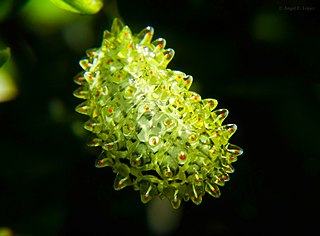Acraga ciliata is a moth of the family Dalceridae. It is found in Jamaica. It is found in a wide range of habitats, ranging from dry to wet and from sea level to 1,300 meters.

Acraga coa is a moth of the family Dalceridae. It is found in southern Mexico, Belize, Honduras, Guatemala, El Salvador, Costa Rica and Panama. The habitat consists of tropical wet, tropical moist, tropical premontane wet, tropical premontane rain, tropical lower montane moist, subtropical wet, subtropical moist, subtropical dry and warm temperate wet forests.
Acraga ampela is a moth in the family Dalceridae. It was described by Herbert Druce in 1890. It is found in Colombia, Peru and Bolivia. The habitat consists of tropical wet, tropical moist, tropical premontane wet and tropical lower montane wet forests.
Acraga boliviana is a moth in the family Dalceridae. It was described by Walter Hopp in 1921. It is found in Bolivia and western Brazil. The habitat consists of subtropical moist forests.
Acraga angulifera is a moth in the family Dalceridae. It was described by Schaus in 1905. It is found in Trinidad, Venezuela, Surinam and French Guiana. The habitat consists of tropical moist forests.
Acraga ochracea is a moth in the family Dalceridae. It was described by Francis Walker in 1855. It is found in southern Brazil, Paraguay and northern Argentina. The habitat consists of tropical premontane moist, subtropical wet, subtropical moist, subtropical dry and warm temperate moist forests.
Dalcerides sofia is a moth in the family Dalceridae. It was described by Harrison Gray Dyar Jr. in 1910. It is found in southern Mexico, Guatemala, El Salvador, Nicaragua and Costa Rica. The habitat consists of tropical moist, tropical dry, tropical premontane wet, subtropical moist, subtropical dry and warm temperate wet forests.
Dalcerides dulciola is a moth in the family Dalceridae. It was described by Harrison Gray Dyar Jr. in 1914. It is found in southern Mexico, Costa Rica, Panama, northern Ecuador and northern Venezuela. The habitat consists of tropical wet, tropical moist, tropical premontane wet and tropical premontane rain forests.
Dalcerides mesoa is a moth in the family Dalceridae. It was described by Herbert Druce in 1887. It is found in southern Mexico, Guatemala, Costa Rica, Panama, Colombia, Venezuela and Ecuador. The habitat consists of tropical wet, tropical moist, tropical dry, tropical premontane wet, tropical premontane rain, subtropical wet and subtropical dry forests.
Dalcerides nana is a moth in the family Dalceridae. It was described by Paul Dognin in 1920. It is found in southern Brazil. The habitat consists of subtropical wet and subtropical moist forests.
Dalcerides rebella is a moth in the family Dalceridae. It was described by Schaus in 1911. It is found in Costa Rica and Ecuador. The habitat consists of tropical wet and premontane wet forests.
Zikanyrops dubiosa is a moth in the family Dalceridae. It was described by Walter Hopp in 1928. It is found in Bolivia.
Dalcerides chirma is a moth in the family Dalceridae. It was described by Schaus in 1920. It is found in southern Mexico and Guatemala. The habitat consists of tropical moist and subtropical wet forests.
Dalcera semirufa is a moth in the family Dalceridae first described by Herbert Druce in 1910. It is found on the western slopes of the Andes Mountains in Colombia. The habitat consists of tropical wet and tropical rain forests.
Minacraga indiscata is a moth in the family Dalceridae. It was described by Harrison Gray Dyar Jr. in 1910. It is found in French Guiana, north-western Brazil and Peru. The habitat consists of tropical moist forests.
Minonoa elvira is a moth in the family Dalceridae. It was described by Paul Dognin in 1909. It is found in Colombia. The habitat consists of tropical lower montane and premontane wet forests.
Paracraga amianta is a moth in the family Dalceridae. It was described by Harrison Gray Dyar Jr. in 1909. It is found in Guyana. The habitat consists of tropical moist forests.
Paracraga argentea is a moth in the family Dalceridae. It was described by Schaus in 1910. It is found in Mexico, Honduras, Belize, Guatemala, El Salvador, Costa Rica and Panama. The habitat consists of tropical wet, tropical moist, tropical premontane wet, tropical premontane moist, subtropical wet subtropical moist forests.
Paracraga pulverina is a moth in the family Dalceridae. It was described by Schaus in 1920. It is found in Guatemala. The habitat probably consists of tropical moist forests.
Minacraga aenea is a moth in the family Dalceridae. It was described by Walter Hopp in 1921. It is found in south-eastern Brazil. The habitat consists of subtropical wet and moist forests.
